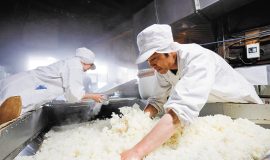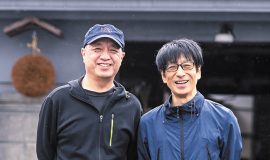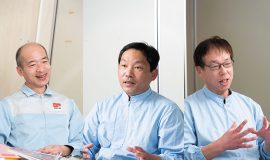Force Coming out of Brewery in the Mountains, Character Built on Unique Ideas and Playfulness
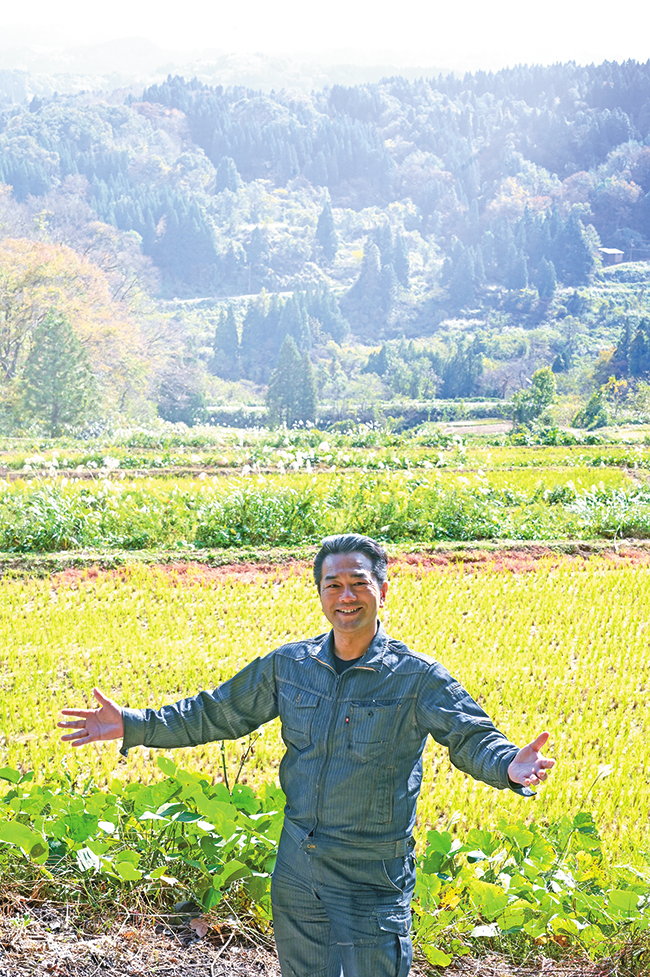
Provoked by Low Reviews into Brewing
Located in the south-eastern part of Niigata Prefecture, Joetsu City is ranked 4th in the country for its rice field acreage, and as such a renowned rice production region. We witness this fact on our way from the city to Niigata Daiichi Shuzo, surrounded by endless rice paddies. We wonder if the flocks of birds pecking at rice ears on the ground are swans. They are the herald of winter, the season when brewing begins in earnest.
Such a harbinger of winter is in their brand name, Koshi No Hakucho, or Swan of Koshi (an old name of the region), and Niigata Daiichi Shuzo has continued their locally rooted brewing after four neighboring breweries—Kameya, Koshi No Tsuyu, Oshima, and Izumiya—merged into one entity under the Small and Medium Enterprises Modernization Act. Daiichi, or No. 1, refers to the fact that this merger was the first case in the prefecture to apply the Act. Later, Ichikawa Shuzo joined the company, making it in the end a merger of 5 breweries. The new company grew around the production of futsu-shu, and at their peak, marked 4,000 koku (approx. 720 kilo liters). The current and 4th generation CEO is Yoshinori Takeda, who in 2008, when his father, Seiji, became chairperson, succeeded to the position. Previously, he had worked as head of brewing for about 15 years since 1999. Takeda confesses, “I wasn’t really interested in sake brewing in the past.” But there was an incident that pushed him to become toji.
“After I graduated from university, I began working for the brewery. I was in sales, and was ambitious to improve numbers, so I would go to retail stores that did not have business with us. However, everywhere I went, they told me ‘Hakucho—that’s not tasty.’ It was brutal.”
Takeda was appalled that his sake was utterly dismissed, and asked why, to which the response was “Hakucho never won any awards.” He requested his toji to brew sake that can win in competitions, but was declined. “I have to do it,” Takeda made up his mind to learn sake brewing from scratch and enrolled himself at the brewing seminar offered by National Research Institute of Brewing, then located in Takinogawa, Kita City, Tokyo. He wrote to the Institute and pleaded that it was critical that he took the seminar before the brewing season started in autumn. After a month and half of the seminar, he got back to the brewery where brewing was about to begin. Takeda looks back: “I was trying to practice what I had learned, and worked literally looking at the textbook. If I came across any issue, I immediately called the instructor,” and he laughed. Sticking to the basics bore fruit the first year. His sake was awarded the 3rd place in the regional competition. The region including Uragawara District where Niigata Daiichi Shuzo is located is the stronghold of the largest school within Echigo Toji Guild, called Kubiki Toji. There were numerous toji from the area who would travel throughout Japan to brew sake, and then come back and enter sake they brewed at the respective brewery in the regional competition—that is the unique local competition in which Takeda’s sake was appraised.
“There was a bit of commotion when they saw a label they had never seen win an award.” But that was not the end. Two years later, Takeda won the 1st place. Further, his sake was increasingly better appraised at the prefectural association and the Tax Agency’s regional Kanto Shinetsu Sake Awards, and Takeda viscerally felt the tides turn. He told us: “My competitive spirit must have lent me the strength.” His attitude to keep challenging without dwelling in the current evaluation would play a role in the birth of new brand, Yamma, which propelled the brewery’s name reach further afield.
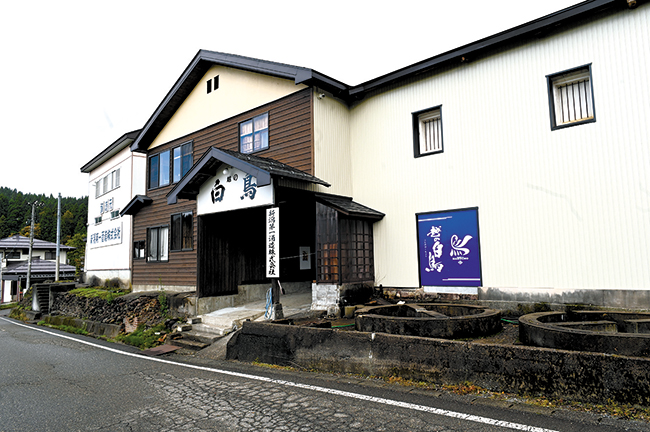
▲Brewery building is of the former Kameya Shuzo (established in 1922). It has withstood 3 earthquakes, and suffered damage when walls collapsed.
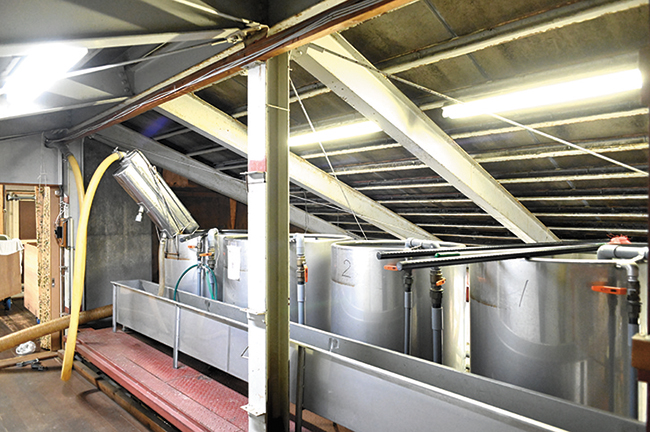
▲Soaking vats inherited from mass production era tends to result in unevenness, and requires careful adjustment. It is critical that they test the soaking time beforehand in order to ensure consistency.
Branding Strategy with Radical Differentiation
Niigata Daiichi Shuzo has two main brands, Koshi No Hakucho and Yamma. Koshi No Hakucho is the brand that was established when the company was incorporated, and was chosen in a public competition with a cash prize. The other label, Yamma, was a product of Takeda in 2007 during his tenure as head of production. Eighty percent of Yamma is distributed outside of the prefecture, and was instrumental in exposing Niigata Daiichi Shuzo to a wider audience. Both brands feature an umami-rich flavor profile, and are distinct from the typical crisp and dry Niigata sake, but that is not the only common factor between the two. In fact, the two brands come from the same fermentation mash. What separates them is the timing of bottling after pressing. In pressing sake, fractions are distinguished, the first being called “arabashiri,” the middle “nakadori,” then the last “seme.” The flavors are different from each other, as the beginning of the press offers freshness and some cloudiness, the middle gets more balanced, and the end imparts more concentration and complexity. At Niigata Daiichi, Koshi No Hakucho is a blend of arabashiri and seme, while Yamma is muroka genshu (unfined, undiluted sake) of nakadori. In the same vein as single malt whisky, they label products by the tank. We asked Takeda about this bold idea.
“I taste my sake extremely frequently. When I got the idea, I was doing a tasting of the freshly pressed sake, and realized how beautiful the nakadori part was. So I decided to bottle just the middle press.”
They bottled the middle part right away, and brought it to a retail store they had a close relationship with. It became a sensation. They sold it periodically from then on, and once they were able to achieve a stable production cycle, they named it Yamma. “In the mountains”—it expresses the geographical location of the brewery, as well as it is inspired by the famed agricultural machinery brand. They also ship seasonal bottles such as “Yambo” with arabashiri, “Mabo” with seme, “Ganho” with small-batch kimoto after Yutaka Iwasaki, the current head of brewing (characters of “Gan” and “Ho” are taken from Iwasaki’s name).
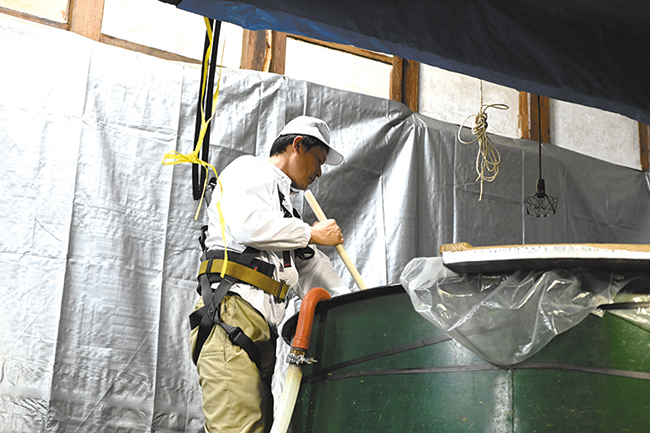
▲Basic unit of brewing is 1,500 kg. About 25 tanks are brewed from October to early May. Staff must wear harnesses when they stir the mash to prevent them from falling in the tank.
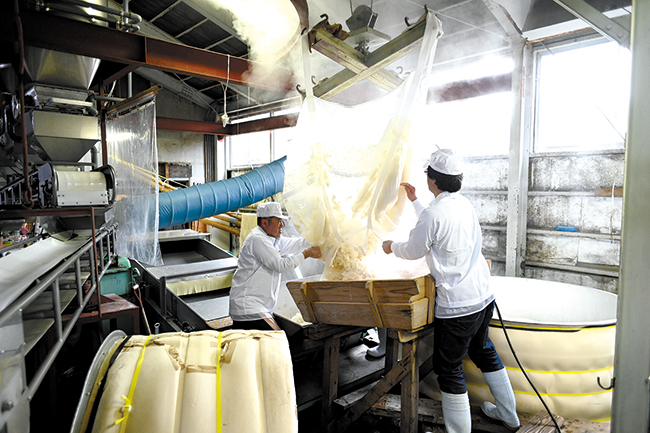
▲Steamed rice is lifted with a crane. Koji rice is sent to koji room still warm, but rice for main fermentation is cooled with outside air before being sent in the tube using compressed air into the tanks.
1 2


